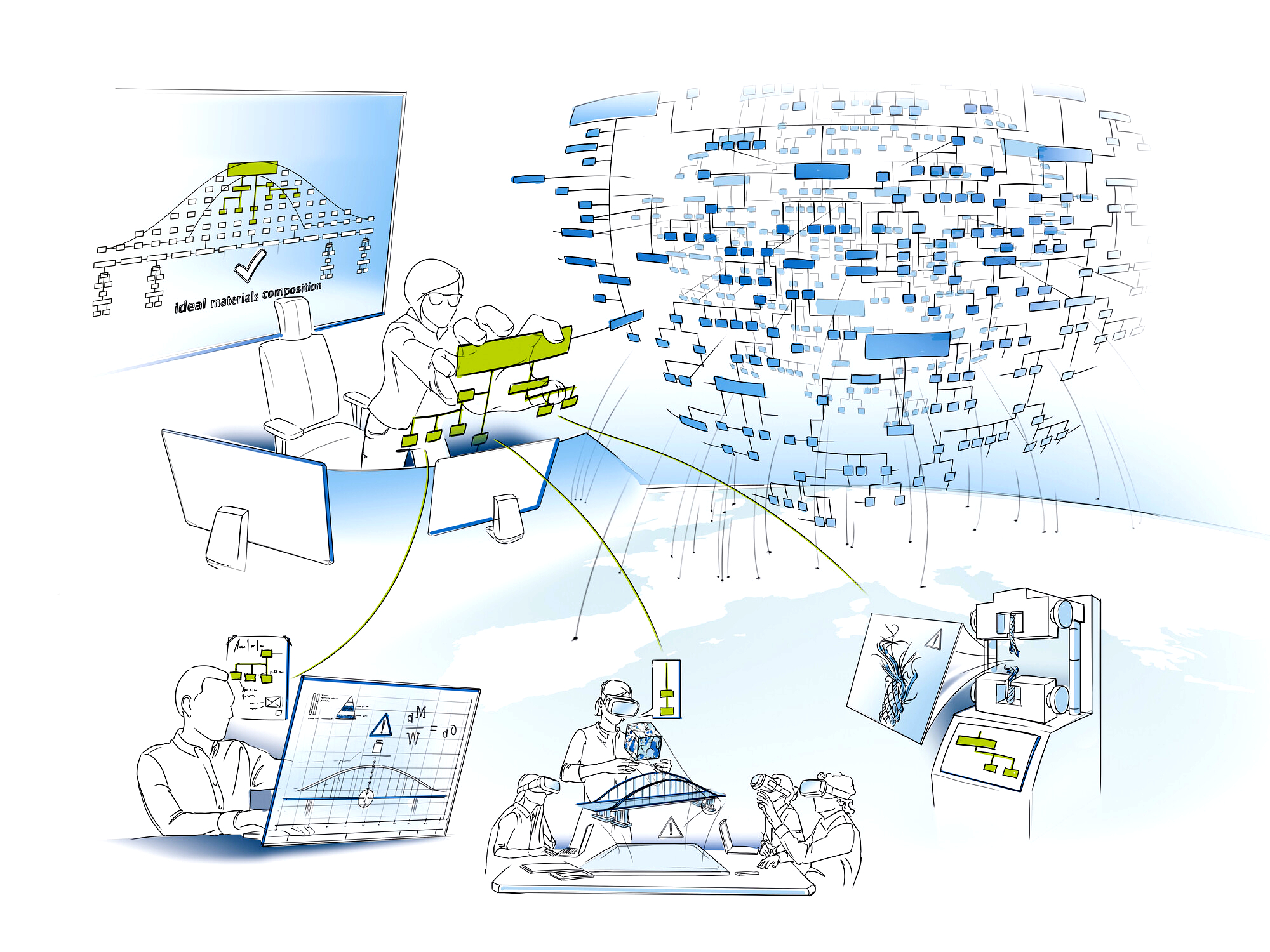Five year of funding for the consortium NFDI-MatWerk
Materials Science and Engineering institutions collaborate on implementing a distributed research data infrastructure
In a collaborative effort to tackle the enormous challenge of building a common National Research Data Infrastructure NFDI, entire research areas across Germany are working together in subject-specific consortia. As one of ten consortia in the second round, NFDI-MatWerk is now receiving five years of funding for Materials Science and Engineering. The consortium consists of renowned research organizations, including 10 applicants and 15 associated partners and is represented by the speaker Prof. Dr. Chris Eberl from Fraunhofer Institute for Materials Mechanics. It focuses on the infrastructure development for a shared materials data space.

The Gemeinsame Wissenschaftskonferenz GWK decided on July 2, 2021 to fund the NFDI-MatWerk consortia. It followed the recommendation of the expert panel and the German Research Foundation DFG. The first funding phase for NFDI-MatWerk is planned to go from October 2021 to September 2026. A total of 18 consortia applied for funding in various scientific areas in this second round for the National Research Data Infrastructure NFDI in a competitive process, 10 of which were recommended for funding.
Materials are the basis for our modern technology
The aim of materials science and materials engineering is to characterize the physical mechanisms in materials and to develop resource-saving high-performance materials with the most ideal properties possible for the respective application. Manufacturing processes are investigated accordingly and designed so that materials and component systems have the necessary service life and can be used in a circular economy and consuming as little resources as possible. Materials’ experts optimize from the atomistic scale to the macro or component level. Processing steps influence the internal material structure on the various scales and thus determine the mechanical and functional properties. Today, research groups still use their own tools and standards for data processing and storage for the data they generate through experiments and simulations. Therefore, sharing data and software tools is unfortunately a tedious task.
The Materials Science and Engineering community is developing a common research data infrastructure
'We are excited that NFDI-MatWerk can start now and that we will be able to help in this community effort: to systematically develop a materials data space and make it securely accessible in the long term', says Prof. Chris Eberl from Fraunhofer IWM. The envisioned digital data space infrastructure must be able to map the various highly complex interrelationships between different materials data and be as seamless to use as possible in order to enable synergy effects. Data from the scientific groups distributed across Germany and beyond should be accessible via a so-called knowledge-graph-based infrastructure. That will allow fast, complex search queries and data evaluations to find new correlations. Such a technical achievement will also provide an excellent basis for next-generation artificial intelligence in the field of materials engineering. As a research community, we see NFDI-MatWerk as a unique opportunity to bundle the numerous activities in the field of research data management, thereby increasing the scientific productivity of researchers.
The consortium covers the majority of the MatWerk community in Germany
The NFDI-MatWerk consortium, coordinated by the Fraunhofer Institute for Mechanics of Materials IWM, consists of experts from the fields of materials science and materials engineering as well as mechanics. The applicant institutions are:
- Deutsches Forschungszentrum für Künstliche Intelligenz
- FIZ Karlsruhe – Leibniz-Institut für Informationsinfrastruktur GmbH
- Forschungszentrum Jülich GmbH
- Fraunhofer-Gesellschaft für angewandte Forschung e.V.:
- Fraunhofer-Institut für Werkstoffmechanik IWM
- Fraunhofer-Institut für Werkstoff- und Strahltechnik IWS
- Friedrich-Alexander-Universität Erlangen-Nürnberg
- Karlsruher Institut für Technologie KIT
- Max-Planck-Institut für Eisenforschung GmbH
- RWTH Aachen
- Technische Universität Bergakademie Freiberg
- Universität des Saarlandes
The associated institutions are:
- Albert-Ludwigs-Universität Freiburg
- Bundesanstalt für Materialforschung und -prüfung (BAM)
- Christian-Albrechts-Universität zu Kiel
- Deutsche Gesellschaft für Materialkunde e.V. (DGM)
- Deutscher Verband für Materialforschung und -prüfung e.V. (DVM)
- Gesellschaft für Angewandte Mathematik und Mechanik e. V. (GAMM)
- Helmholtz-Zentrum hereon
- Leibniz-Institut für Werkstofforientierte Technologien - IWT
- Physikalisch-Technische Bundesanstalt Braunschweig und Berlin (PTB)
- Ruhr-Universität Bochum
- Technische Universität Clausthal-Zellerfeld
- Technische Universität Darmstadt
- Technische Universität Kaiserslautern
- Universität Paderborn
- Universität Stuttgart
About the National Research Data Infrastructure
The National Research Data Infrastructure (NFDI) has the objective to systematically index, edit, interconnect and make available the valuable stock of data from science and research. So far, these data have mostly been available in a decentralized, project-related, or temporary form. The federation and the states funds the NFDI jointly. Digital data storage is an indispensable prerequisite for treating new research issues, generating findings, and making innovations (Nationale Forschungsdateninfrastruktur NFDI). In November 2018, the federal and state governments decided to establish a National Research Data Infrastructure NFDI and intend to fund up to 30 consortia in total. In the final stage, up to 85 million euros per year are to be made available for this purpose.
- Nationale Forschungsdateninfrastruktur NFDI e.V. www.nfdi.de/en-gb
- DFG, German Research Foundation - National Research Data Infrastructure www.dfg.de/en/research_funding/programmes/nfdi
- National Research Data Infrastructure for Materials Science & Engineering NFDI-MatWerk www.nfdi-matwerk.de
Contact:
Prof. Dr. Christoph Eberl
Phone +49 761 5142-495
Send email
Markus Niebel
Phone +49 761 5142-326
Send email
 Fraunhofer Institute for Mechanics of Materials IWM
Fraunhofer Institute for Mechanics of Materials IWM